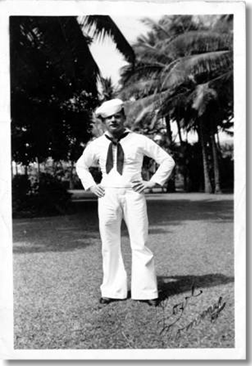The ONE Exhibition,
The Roots of the LGBT Equality Movement
ONE Magazine &
The First Gay Supreme Court Case In U.S. History
1943-1958
The vast majority of recruits hailed from rural, small town communities from across the nation, and according to historian Allan Berube, with “no publicly gay leaders or organizations to act on their behalf, no press to acknowledge their existence or the problems they faced, no discussions of homosexuality on the radio,” rural gay Americans before WWII tended to be fairly isolated, and were often unaware of any sort of gay social networks or others like themselves.
In the postwar years these networks would prove to be vital for social networking and provided an important foundation upon which the fledgling gay community would grow. Thus, WWII is sometimes thought of as “America’s 1st coming out.”
Before WWII, the military did not have a policy specifically targeting gay servicemen. Historian Alan Berube wrote in his seminal book on gays in WWII, Coming Out Under Fire The History Of Gay Men And Lesbians In World War Two, that before WWII the U.S. military had inherited longstanding British policies against sodomy, generally defined as anal and sometimes oral sex between two males. Under these policies any man, regardless of sexual orientation, could be sentenced to prison time for committing the act. Other than this, the military generally refrained from targeting gays, and in fact, gay men were thought to make good secretaries.
During WWII millions of young men enlisted, and military policies changed dramatically as officials began to set higher standards for military service. Military psychiatrists encouraged officials to carefully screen recruits for mental as well as physical fitness, and questioning about homosexuality became a regular part of the preliminary vetting of recruits. These new standards specifically excluded certain groups from service as it was believed that they were unfit for military duty; it was believed they would make poor combat soldiers, or their presence in units would threaten troop morale and discipline. These groups included women, African Americans in the Marines and Army Corps, and homosexuals.
According to Berube, during WWII the military’s integration of these policies would “force military officials to develop an expanding administrative apparatus for managing homosexual personnel that relied on diagnosis, hospitalization, surveillance, interrogation, discharge, administrative appeal, and mass indoctrination.” These policies of surveillance did not end at the front gates; throughout the war thousands of gay and lesbian veterans were given “blue discharges” for being “undesirable,” as the military juggernaut institutionalized surveillance and investigations of gay men and lesbians, who were considered sexual inverts, or sexual perverts at the time. These "blue discharges," as they came to be known, included large numbers of black and homosexual veterans. Additionally, Berube writes that "undesirable" diagnoses were often used to discharge soldiers for “vague ‘undesirable traits of character’ by officers who wanted to get rid of ‘problem’ soldiers - blacks, homosexuals, and psychopathic personalities (alcoholics, drug addicts, liars, [and] troublemakers).”
It was the beginning of an era of persecution for gays in the military that continued for decades to come and foreshadowed the gay purges in the federal government throughout the 1950s.
.

Photo of sailor with alligator during World War II that reads: “To Max: Words cannot express my thoughts. As ever, Max".
Photographer unknown. ONE Archives at the USC Libraries, Los Angeles, California.
During World War II, millions of young men and women were deployed across the nation and around the world to serve their country. Many experienced gender-segregated military housing, living in close quarters surrounded by hundreds of young recruits of the same gender.
In many cases they were free for the first time from the constraints normally imposed by the watchful eyes of their families and the traditional values of their communities they had lived under all their lives.
As such, during the war many of those who had homosexual inclinations encountered others with similar tendencies for the first time.
Flirtations developed into camaraderie, sexual exploration, intimate friendships, and lifelong relationships as gays and lesbians created networks of friends that stretched from coast to coast and around the globe.


Black and white photo of a sailor from World War II signed “Love Tommy” on front and “Just a good pal and a sailor” on reverse. Photographer unknown. Courtesy of the ONE Archives at the USC Libraries, Los Angeles, California.


Soldiers sitting together during World War II. Undated. Photographer unknown. Courtesy of the ONE Archives at the USC Libraries, Los Angeles, California.

Servicemen relaxing during World War II. Undated.
Photographer unknown. Courtesy of the ONE Archives at the USC Libraries, Los Angeles, California.
Group of servicemen from B Battery 560 FA BN, Camp Polk, Louisiana 1951. Photographer unknown. Courtesy of the ONE Archives at the USC Libraries, Los Angeles, California.
Sailors embrace and kiss in a photo booth during World War II. No signature. Undated. Photographer unknown. Courtesy of the ONE Archives at the USC Libraries, Los Angeles, California.
The War Years

Three Servicemen of the #3 Wireless School relax at Tuxedo Park, Manitoba, Canada 1942. Photographer unknown. Photo courtesy of Google Images.

Photo of serviceman posing with mop. Caption reads: Tom H. Brown Jr., 4 Sep ’55, Portsmouth, VA Sailors Hotel, N.Y. On back of photo: “I’m afraid this if IT for awhile until I find a more recent picture. As ever, JM” April 1956.
Photographer unknown. Courtesy of the ONE Archives at the USC Libraries, Los Angeles, California.

Photo caption: Soldier posing at Camp Polk, Louisiana 1951. Photographer unknown. Courtesy of the ONE Archives at the USC Libraries, Los Angeles, California.
.
